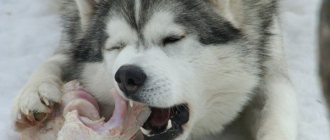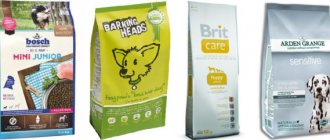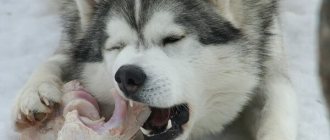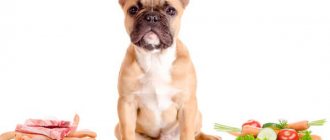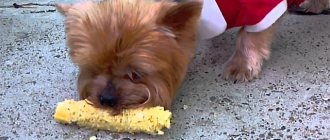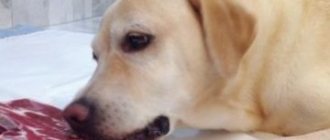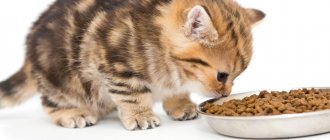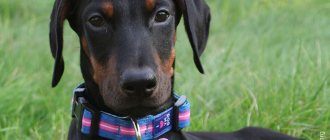Basic rules for feeding Labradors
Dogs of this breed are omnivores and love to eat, so a caring owner should carefully monitor the pet’s diet. Labradors are prone to metabolic disorders, overweight and even obesity. For this reason, they often develop severe heart and vascular diseases.
Labrador Retrievers love to eat.
Due to excess weight, bones and joints suffer, as a result, large dogs develop arthritis, arthrosis and other diseases of the musculoskeletal system. The liver and kidneys also cannot withstand excessive stress. In addition, Labradors are susceptible to allergies. Therefore, the diet must be balanced so that fat deposits do not appear in the dog’s body.
Basic rules for feeding a Labrador:
- Under no circumstances should you feed your pet food from a human table.
- Your dog should always have a bowl of clean water to drink. You can calculate the required amount of liquid as follows: 50 ml of water per 1 kg of Labradorite weight. For example, if a dog weighs 40 kg, then it should drink at least 2 liters of water per day.
- Giving raw meat and fish to animals is unacceptable. These products need to be cooked.
- The dog is given only fresh food.
- The food should be at room temperature, so it is either heated or cooled.
- You cannot combine dry food and natural food.
- Vitamin and mineral complexes should be added to any food.
- You should always feed your dog at the same time after walking.
- Portions should be the same.
- After lunch, the pet should rest; this is necessary for normal digestion.
- The diet for a Labrador is selected gradually. If he refuses to eat, you cannot force him. We need to offer another dish.
- Dishes should be washed after each feeding.
Low-fat cottage cheese is an excellent source of calcium
It is very important to choose the right dishes for your pet. The ideal option is 2 aluminum or enameled deep plates. One for food, the other for water. The surface of the cookware should be smooth, without cracks, chips or sharp edges. Dogs love to lick their bowls and can get hurt.
You can tell by a dog's appearance whether it is eating properly. Signs of a healthy diet:
- normal weight;
- shiny wool;
- the cheerful appearance of the animal, its activity.
Signs of poor nutrition:
- being overweight or thin;
- lethargy, weakness;
- dull, faded fur.
Advice! You can measure the required amount of dry food using measuring cups.
Water in a Labrador's diet
Water is the most important component of a dog's diet. Despite the fact that natural food contains enough moisture, the puppy should not limit access to fresh water. In the case of feeding dry foods, this issue is especially relevant. The bowl must be washed frequently and the water changed. Tap water is suitable for a pet only if the owner is confident in its quality. It is unacceptable to allow your dog to drink from puddles.
The water bowl should be secured: Labradors are notorious for knocking over dishes and sleeping on damp floors.
How much and how often to feed
Labrador retrievers need to be fed 2 times a day: morning and evening. When choosing a pet's diet, you need to find out how much a Labrador eats per day. The amount of feed should always be the same. It depends on age, gender, degree of physical activity, climate, characteristics of the dog and even the time of year.
How to train a Labrador at home for beginners
In the harsh northern climate, as well as in cold weather, the dog should eat 15-20% more food than usual. During hot weather, animals are often thirsty, but their appetite decreases, so the amount of food must be reduced and the amount of water, on the contrary, increased.
Important! When choosing a diet for an elderly pet, you need to reduce the amount of carbohydrates by 20%.
The diet of sterilized dogs should be low in calories. Animals that are being prepared for mating require a lot of food. Males eat 10–15% more than females.
Puppies, pregnant, lactating and older dogs especially need a healthy diet
Weekly menu for Labrador (natural food)
It is difficult for a new owner to independently create a pet’s menu so that it includes all the necessary components, so we offer an example of a weekly diet for an adult Labrador on a natural basis.
| Day of the week | Morning | Evening |
| Monday | Cottage cheese with sour cream and fresh vegetables | Rice boiled in broth + beef |
| Tuesday | Yolks with vegetables and a piece of cheese, raw beef | Chicken breast with buckwheat, add greens |
| Wednesday | Kefir with herbs | Rice porridge with broth, beef heart + liver |
| Thursday | 2-3 quail eggs, fresh vegetables | Sea fish with buckwheat |
| Friday | Finely chopped vegetables with pieces of raw meat | Rice, chicken fillet, greens |
| Saturday | Bifidok and water porridge with vegetables | Buckwheat porridge in broth, beef by-products: heart, lung, udder |
| Sunday | Porridge with rye bread crackers and herbs, cottage cheese | Raw tripe with boiled buckwheat |
The diet can vary, as can the number of meals. How many times a day to feed your Labrador is up to you, the main thing is to take into account the dog’s physical activity. Supplement the menu with vitamins and mineral complexes, select the correct ratio of fats, proteins and carbohydrates, monitor your pet’s reaction to food and then you will keep his health for many years.
Food for a puppy at 1 month of age
If a puppy appears in the house, he needs to choose a nutritious diet that will keep the babies healthy. Their entire future life will depend on this. You need to know well how to feed a Labrador puppy, how many times a day, and what foods are good for him.
What to feed Shar Peis at home: which food is better
The daily amount of food for a puppy aged 1 month should be 5-7% of its weight. You need to remember what to feed your Labrador puppy. The most important products:
- meat - 50% of the daily diet;
- cereals - 30%;
- cottage cheese, kefir, fruits, vegetables - 10%.
Each new product should be introduced into the diet gradually and the dog’s well-being should be carefully monitored in order to notice an allergy in time.
You can feed your baby premium dry food designed specifically for small puppies. The veterinarian will help you choose the best option. Many owners give puppies liquid porridge and meat pates or broths.
Important! It is necessary to monitor weight gain. On average, a Labrador at this age should weigh 3.4–3.8 kg.
A one-month-old puppy is fed little by little, but often: 6 times a day, but not at night. Sample menu for the day:
- porridge with butter and 1 glucose tablet;
- meat and vegetable puree;
- cottage cheese;
- meat broth;
- boiled meat;
- cottage cheese.
Until the puppy's permanent teeth erupt, it is necessary to soak the dry food in water.
After the baby turns 3 months old, the frequency of feeding can be reduced to 5 times.
Pumpkin - anti-worm remedy
About baby nutrition
From the first months of life, Labradors are active and explore life with interest. They move a lot, play, and grow quickly, so their diet should be quite rich. On the other hand, you need to focus on an early age, because some foods are still too heavy for a growing body. The size of puppy food is indicated on the packaging. You can calculate the serving size of natural food based on the following table:
| Age (months) | 1 serving (kg) | Feedings per day | Daily value (gr.) |
| Up to 2 | 0,05 | 6 | 0,3 |
| Up to 4 | 0,06-0,08 | 5 | 0,3–0,4 |
| Up to six months | 0,1 | 4 | 0,4 |
| 7-11 months | 0,13 | 3 | 0,4 |
| Older | More than 0.35 | 1-2 | More than 0.7 |
Let's look at the specifics of feeding a Labrador by month with natural food or ready-made pellets. What does the menu consist of?
1 month – start of complementary feeding
A month is a time when the dog is very small and requires special attention. Until a month old, the puppy must feed on breast milk, so at this time the babies are not yet torn away from their mother. If you have a newborn, then it is permissible to feed a 1-month-old Labrador puppy with boiled milk.
Next, you need to start complementary feeding. If the puppy has just been adopted, check with the breeders what kind of food he is used to, so that at first he adheres to its principles.
After a month, it is advisable to continue breastfeeding, while simultaneously complicating the diet. Add:
- Dry food soaked in fermented milk (for example, kefir or biolact). The granules should not contain chicken, it is too aggressive an allergen for this age. (This option is suitable for those who subsequently plan to feed the dog dry food).
- Thin buckwheat or rice porridge.
- Chopped vegetables: carrots, zucchini, celery, pumpkin. Potatoes, peas, and white cabbage are not allowed.
- Cottage cheese.
- Fish or dietary meat (pureeed). Baby food jars work well.
Salt, sugar and other seasonings are completely excluded from the Labrador's diet.
After the second month
At this time, weaning begins. It is desirable that it be gradual. A Labrador puppy at 2 months old should be fed the same diet as before, but the proportion of meat products increases and the amount of milk decreases. Cottage cheese is replaced with finely chopped beef or poultry, fish. You can prepare semi-thick soups. Add 1-2 eggs per week, vegetable oil, herbs.
After each new product, watch your body’s reaction. If an allergy appears or a bowel disorder occurs, it is better to postpone this type of complementary feeding for 1-2 weeks.
Three to six months
The basis of the diet remains the same, but the ratio of products and the type of their preparation changes. The milk fades into the background, leaving only kefir and cottage cheese. For lunch they serve thick soups, add finely chopped meat or poultry, vegetables and herbs. Porridge is now cooked in a light broth.
Gradually accustom the puppy to solid food, he should learn to chew. Slices of fresh vegetables or fruits (for example, carrots and apples) are well suited for this purpose. Fish oil and powdered eggshells are suitable natural mineral supplements.
Diet for Labradors up to 12 months
At this age, active growth of muscle and bone mass begins, the puppy moves a lot, explores the world around him and his own capabilities. He spends a lot of internal resources, so they need to be replenished. Calcium and protein are especially needed. These substances are fully contained in meat; it becomes the basis of the diet. Porridge and soups are cooked with it. After six months, you can add offal to the menu: lungs, heart, liver, etc. It is better if they are beef.
You can give sea fish, the main thing is to thoroughly clean it of bones. Vegetables, fruits and herbs also remain on the menu. Fermented milk products are given 1-2 times a week. At the age of 6 to 12 months, complex vitamin supplements are especially relevant; they will compensate for the deficiency of vitamins and minerals and contribute to the full formation of the skeleton.
If you feed your dog dry food, then choose professional producers. Dry food for a Labrador puppy should have the label “Puppy” or “Junior” on the packaging.
How should an adult dog eat?
The diet of a Labrador retriever older than 1 year should be lower in calories than that of small puppies. You need to give your dog a balanced diet that contains all the nutrients. The daily amount of food for a dog should include 15 g of protein (meat), 1 g of fat and 5 g of carbohydrates per 1 kg of animal weight.
What to feed a toy terrier at home
Adult dogs eat 2 times a day. They can be fed natural food or super premium dry food. All packages have a table indicating the age and weight of the dog, with which you can calculate the required amount of food per day.
Important! Pumpkin helps remove helminths from the body.
Older animals have special nutritional needs. Dogs over 7 years old will need special food, which must be chosen on the recommendation of a veterinarian.
You will need premium food and holistic food
Vitamins and mineral supplements
When feeding natural products, a Labrador's nutrition without vitamin complexes and mineral supplements will not be complete.
These components are necessary to maintain the body of a puppy and an adult dog in proper condition and the ability to resist disease.
A sufficient amount of vitamins is contained in the foods that form the basis of the dog’s diet. Eg:
- fish and fish oil are suppliers of vitamin A;
- meat, fish, cheese provide the need for B vitamins;
- seaweed contains substances that keep skin and coat in good condition;
- fish, buckwheat, and meat contain a sufficient amount of vitamin PP, which prevents the appearance of cracks in the dog’s tongue and skin.
The most effective artificial drugs are:
- GLUCOSAMINE. The presence of calcium, vitamin C, trace elements and glucosamine strengthens ligaments and cartilage and prevents joint diseases.
- "8 in 1" EXCELBREWERSYEAST. An effective vitamin complex used for the full development of puppies.
- CALCIDEE. The vitamin complex contains a high content of calcium, phosphorus and vitamin D.
- NUTRICOAT CAROBFLAVOR. The composition ensures a healthy shine and beauty of the dog's coat.
The choice of vitamin complexes and nutritional supplements should be left to your veterinarian. The list here is for informational purposes only.
Feeding a Labrador requires a responsible and competent approach from the owner.
When using ready-made feed or products of natural origin, you should remember the basic rules - balance of components, compliance with dietary requirements, compliance of the daily volume of food consumed with the age and weight characteristics of the animal.
I like it I don't like it
Balanced natural nutrition: do's and don'ts
When choosing a natural diet, you need to remember well which foods are healthy for dogs and which they should not eat.
What do Labradors eat:
- lean meat of chicken, rabbit, turkey, beef, horse meat;
- low-fat sea fish - cod, pollock, pike perch, hake;
- eggs - during the week you can add no more than 1-2 yolks to the porridge;
- vegetables - zucchini, carrots, pumpkin;
- fruits - apples;
- fermented milk products - cottage cheese, kefir, fermented baked milk, yogurt without additives, grated low-fat cheese;
- cereals - wheat, rice, corn, buckwheat;
- greens - parsley, dill, lettuce, celery;
- sea salt - allowed in minute quantities.
The fish must be boiled and all bones removed. Labradors can eat offal, but they need to be cooked for a very long time. Egg whites are not digestible, so they should not be offered to your dog.
Vegetables and fruits can be given raw or boiled. They must first be cut or grated. During cooking, add a spoonful of fish oil and vegetable oil (olive, flaxseed, sunflower, corn) to the porridge.
Acana Grass-Fed Lamb
List of foods that Labradors should not eat:
- any fatty food;
- bones are deadly;
- sausages and frankfurters, especially smoked ones;
- River fish;
- chocolate and other sweets;
- milk;
- cereals - oatmeal, semolina, pearl barley;
- vegetables - potatoes, onions, broccoli, cabbage;
- fruits - grapes, currants, avocados, citrus fruits;
- legumes;
- bread, pasta, pastries;
- mushrooms;
- nuts;
- spices, marinades, spices, pickles.
Important! Many Labradors are allergic to buckwheat.
Meat in the Labrador's diet
To find out what to feed your Labrador at home, it is important to understand what place meat products occupy in its diet. Half of a dog's daily diet should consist of meat. It is advisable to feed your pet low-fat varieties of beef, chicken, turkey, horse meat, and rabbit meat. Brisket, flank, and offal are suitable. Tripe (stomach) can be given raw because it contains a lot of protein. Soft cartilage is suitable as a treat.
Royal Canin
Recipe
In 2 liters of water, boil 600 grams of meat (chicken, fish) until half cooked, add 3/4 cup of cereal (1:1 rice-buckwheat) and chopped vegetables, 2 carrots, 1/2 beets, 1 small onion and 1 clove of garlic, sautéed in vegetable (corn, olive) oil. Cook over low heat for 10 minutes. You can add chopped parsley and dill. Divide into 2-3 feedings.
There is no typical or ideal feeding regimen. You can highlight more healthy and recommended foods, but at the same time take into account that each dog has its own individual habits and tastes. In general, we can say that young dogs are, as a rule, fed a little more, while adults are slightly underfed in order to prevent underdevelopment of the former and obesity of the latter. The frequency of feeding is determined depending on the age of the dog. Feeding an adult dog too often usually leads to various diseases or disorders of the gastrointestinal tract. Regular feeding is absolutely essential. This rule is often neglected, although it is no less important than the volume of feed. A dog that is fed at strictly designated times has a good appetite and better absorbs nutrients. The dog needs to be given a good walk before feeding. Digestion lasts at least six to seven hours, and during this period the dog should not be tired or exercised. It is especially important from a very early age not to give your dog anything between feedings. Have the will and firmly abide by this rule. Sweets, chocolate, cookies and other “treats” burden the dog’s digestive system without any benefit for it.
Ready-made food for large pets
Good dog food contains all the nutrients necessary for animal health. Very often, dog breeders feed their pets industrially produced dry food, because it takes a lot of time to prepare natural food.
You can offer your pet food of premium and super-premium classes, as well as holistic food. Some manufacturers offer special lines for certain breeds. The Royal Canin brand produces food for Labradors - Labrador Retriever Junior for puppies and Labrador Retriever-30 for adults.
Pros and cons of natural food
Natural nutrition involves the dog consuming only high-quality products, the choice of which is the responsibility of the owner, who checks their freshness before purchasing.
This diet has several other advantages:
- variety, eliminating the possibility that the pet will get bored with food;
- absence of preservatives, chemical flavors, dyes and flavor enhancers that do not provide any benefit to the animal;
- if an allergic reaction to one of the products develops, you can simply replace it with an analogue without making other adjustments to the menu;
- All nutrients in a Labrador's diet are of natural origin and are better absorbed.
Disadvantages of natural feeding:
- it takes a lot of time to prepare food;
- drawing up a balanced diet is impossible without certain knowledge;
- difficulties with feeding your pet while traveling.
You should also remember that you cannot prepare food for future use, and your pet needs to cook daily.
Wet food
Wet canned foods occupy a special place in a dog’s diet. They can be combined with dry food or added to natural food. Wet food contains a sufficient amount of proteins, fats and carbohydrates in their optimal ratio. Hypoallergenic food has been developed for pets with allergies.
The best manufacturers of wet canned food are brands such as Hills, Almo Nature, Barking Heads, Advance, Belcando, Eukanuba, Bozita, Acana, etc.
Eukanuba
Pregnant dog
The diet of a pregnant dog should be different from the normal diet.
It should be supplemented with various minerals, acids and vitamins A, E, D, C, B6, B3.
Don't forget about iron. A pregnant dog must eat it.
The best source of iron is beef: beef heart, liver and kidneys.
The diet of a pregnant bitch must include::
- Omega 3 acids . These acids play an important role in the development of the nervous system, vision and brain of the embryo. Their highest content is present in salmon and fish oil. You can also use gelatin capsules with Omega 3.
- Calcium . This mineral is necessary for the development of the teeth and skeleton of the fetus. Calculate calcium at 900 mg per 450 g of food per day. If a pregnant dog eats high-quality food, then its body should have enough of this mineral.
- Folic acid (or vitamin B9) . This vitamin is simply necessary for a pregnant dog. With its help, a number of diseases such as nerve trunk defects, cleft palate and spinal defects are prevented. Large amounts of folic acid are found in pork, liver and poultry. Experts recommend starting to give vitamin B9 before mating (about 2 months) and until birth.
Feed comparison
There are many manufacturers of high-quality dog food. When choosing food for Labradors, you need to take into account the individual characteristics of the pet. If he has an allergy to holistic food, then you need to offer him super premium food.
Royal Canin Labrador Retriever Adult
Adult Retrievers are formulated with the nutrition they need to maintain healthy joints and bones. Dogs chew the granules easily, this helps keep their teeth strong and strong. The food is very filling, so the feeling of fullness comes quickly.
Eukanuba Breed Specific Dry Dog Food For Labrador Retriever
Balanced diet made from dehydrated meat, grains, vegetables. It is rich in fiber, fatty acids, and fructooligosaccharides. Crustacean shells are used as a source of glucosamine. Cartilage contains enough chondroitin.
Hill's Nature's Best Canine Adult Large Breed/Giant dry
Hill's has created a special line for dogs of large and giant breeds. The composition includes a lot of meat, vegetables and grains. Vitamin E (tocopherol) and rosemary are used as preservatives. Chemical dyes are completely absent. This food will provide your dog with vitamins, omega-3 and omega-6 fatty acids, and minerals.
Hills
Advance Labrador Adult
Labradors over 2 years of age will enjoy Advance complete food, formulated with the breed in mind. Made only from natural ingredients, it is perfectly absorbed and nourishes the dog’s cardiovascular system, muscles, joints, coat, and skin. This diet protects your pet from tartar formation and obesity.
Acana Grass-Fed Lamb
Grain-free holistic product that has a beneficial effect on the sensitive digestion of dogs. It is made from meat and vegetables and does not contain products that can cause allergies. The composition includes probiotics and prebiotics that contribute to the normal functioning of the gastrointestinal tract.
Advance Labrador Adult
Rating of the best food for puppies
Natural lamb (meat delicacy), 1016105
Products from domestic manufacturers are in high demand. Purchased for those who are sensitive to synthetic additives. Preservatives, artificial colors, and additives are not used in production. Contents are gelled. Made from selected components. The cooking technologies are the most modern. There were no complaints about quality. The texture is delicious. No need to dilute with water. You can take it to the country or on the road. You don't need a can opener to open the lid. Serves as food for babies up to one year old. Iron cans are used as packaging.
The price per jar is 93 rubles.
Natural lamb (meat delicacy), 1016105
Advantages:
- monoprotein formula;
- quality ingredients;
- versatility;
- ease of transportation and opening;
- affordable price.
Flaws:
- not installed.
Premium Puppy Large with chicken (1011066)
Country of origin: the Netherlands. Designed for puppies of large dog breeds. Enriched with minerals and vitamins, it helps the baby grow and develop properly. It is in high demand due to its significant meat content. Belongs to the category of universal. Can be given to pets up to one year old. The storage location should be dark and cool. Excessive humidity should be avoided.
The average cost is 400 rubles per 1 kg.
Premium Puppy Large with chicken (1011066)
Advantages:
- the presence of healthy fatty acids Omega-6 and Omega-3;
- strengthens muscles and bones;
- improves the immune system;
- convenient packaging;
- positive reviews;
- makes teeth healthy.
Flaws:
- not found.
Hill's Science Plan (1037163)
Products are manufactured in the Netherlands. The main ingredients are lamb and rice. Provides the baby with a start in life and allows him to unlock his potential. Can be given to babies up to 1 year old, as well as to nursing and pregnant women. The presence of high-quality protein allows you to build muscle mass. Docosahexaenoic acid promotes proper development of vision and brain. Minerals strengthen teeth and bones. Not suitable for adult dogs.
Retailers are asking 719 rubles for a package of 800 grams.
Hill's Science Plan (1037163)
Advantages:
- ease of storage;
- excellent taste characteristics;
- balanced composition;
- quality ingredients.
Flaws:
- none.
Puppy and Junior Large (3 kg)
Dry food. Available in granules. Consists of 49% animal ingredients (beef, pork, chicken). Completely meets the animal's protein needs and increases vital energy. Meat is used fresh for cooking. The finished product remains in its own meat juice, which improves its digestibility and taste characteristics.
The purchase price is 453 rubles per kg.
Puppy and Junior Large (3 kg)
Advantages:
- absence of harmful components;
- saturation with minerals and vitamins;
- base - fresh meat;
- There are no GMOs in the composition.
Flaws:
- not installed.
Puppy all breeds lamb & salmon (1035777)
Universal food suitable for puppies of all breeds. Made from salmon and lamb, with the addition of goji berries, herbs, fresh fish and alfalfa. The formula is rich in vitamins, proteins and fats. The berries keep your pet’s immune system at its best, improve hematopoiesis, vision, and the condition of the dermis. Thanks to parsley, the possibility of cancer developing in a dog is minimal. Alfalfa has a beneficial effect on the digestive tract, improves metabolism, and renews cells. Produced at Czech production facilities.
Purchase price – 453 rubles per kg.
Puppy all breeds lamb & salmon (1035777)
Advantages:
- improves the general condition of the animal;
- promotes its active development;
- saturation with minerals and other useful components;
- normalization of digestion;
- kidney cleansing.
Flaws:
- not identified.
Features of feeding during pregnancy and after childbirth
A pregnant and lactating dog needs high-calorie and nutritious food. It is necessary to give them vitamin and mineral supplements and more meat. It is advisable to add new products:
- fennel;
- brown seaweed;
- kelp;
- red viburnum.
The expectant mother needs to be fed 5-6 times a day in small portions. This diet is followed during pregnancy and for another 2 months after childbirth.
There are industrial lines of food designed specifically for pregnant and lactating women - Royal Canin Maxi Starter, Royal Canin Giant Starter, Bosch Reproduction, Belcando Puppy Gravy, Bozita Robur Mother&Puppy X-Large, etc.
How to feed a small puppy
Immediately after the birth of the puppy, it is strictly forbidden to tear it away from its mother.
In the first 24-27 hours after birth, the puppy needs to be fed colostrum (mother's milk).
During the first month, the puppy receives colostral immunity, which protects the newborn from various diseases.
The puppy should be fed mother's milk for up to 4 weeks (exactly one month), but it is best to start feeding it solid food from the third week.
This will help the dog adapt to a different type of food in the future.
The transition should take place gradually, over 10-14 days.
If there is a sudden transition, the dog may experience stomach problems and growth retardation.
If you refuse to eat: possible reasons
Sometimes dogs refuse to eat. In most cases this is normal, but sometimes it can be a sign of illness. You need to urgently contact a veterinarian if the temperature rises, the animal becomes drowsy and lethargic, diarrhea, vomiting, and bloody discharge appear.
If your dog refuses food, don't force it
Common reasons for refusing to eat:
- binge eating;
- changing your diet or daily routine;
- stress, fear;
- estrus;
- toxicosis of pregnant women;
- other hormonal changes.
When a dog misses its owner during his absence, it loses its appetite. If, while teaching the puppy to solid food, the owner was too impatient and showed aggression towards the pet, he may refuse to eat.
A loving and caring owner knows well what to feed a Labrador. Depending on the pet’s health, a diet is prescribed - either natural food or a dry diet with the addition of wet food. Vitamin and mineral supplements must be mixed with food.
What is forbidden to give to dogs of this breed?
As you can see, the diet of dogs is quite varied, however, there is a list of foods that cannot be fed to a Labrador. Among them:
- Legumes, fresh cabbage, cucumbers, and potatoes cause flatulence.
- Sweets and citrus fruits are bad for health and cause allergies. Chocolate destroys tooth enamel and causes watery eyes.
- Pork, lamb, and fatty beef are too difficult to digest.
- Pearl barley and oatmeal, milk provoke diarrhea.
- Bones (especially chicken bones).
- Smoked food destroys liver cells.
- Marinated, spicy, spicy foods harm the stomach, cause heartburn, and “kill” taste buds.
- Bakery products are not digestible and lead to excess weight.
The food must be suitable for dogs, do not feed cat food or human table food.
Friend and comrade
When buying a dog, it is worth remembering that in the near future it will be a close friend and will be nearby all the time.
Labrador is a very special breed, you can only dream of such a friend.
And great effort should be made to ensure that the dog grows up healthy, beautiful and active.
You need to constantly feed your dog on time, remember to change the water and just treat it well. Then you will have a loyal and reliable friend nearby who will serve you for many more years!
More is not better
There is an opinion that the nutrition of a three-month-old puppy should not be limited at all: let him eat as much as he wants, it won’t harm the growing body, they say. Sometimes a single portion, generously sprinkled by a caring owner, significantly exceeds the animal’s daily physiological need in calorie content. This approach is fraught with overfeeding the pet and putting on extra pounds.
They create an increased load on the fragile skeleton and often become the cause of serious chronic diseases. Therefore, if you do not want to become a regular at veterinary clinics, refuse feeding “by eye” and strictly follow the daily intake recommended by the manufacturer.
Owners of Labradors, golden retrievers, Rottweilers, pugs, dachshunds, beagles, English and French bulldogs should be especially careful. These dogs are genetically prone to obesity and require strict portion control even during puppyhood.
